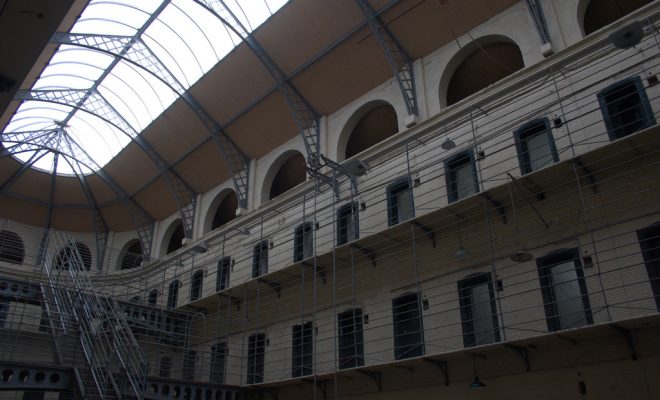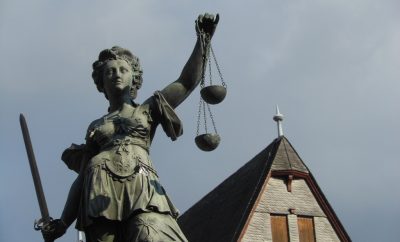 Image courtesy of [Matt B via Flickr]
Image courtesy of [Matt B via Flickr]
Politics
The Juvenile Justice System: Inequality and Unjust Treatment
Across the United States, it is estimated that more than 61,000 youth are incarcerated each night, and more than 65 percent of these young people are youth of color. The overwhelming majority, 75 percent, are incarcerated for non-violent offenses.
The U.S. incarcerates youth at vastly higher rates than any other country in a world. Given that these incarcerated youth die from suicide at a rate of two to three times higher than the non-incarcerated youth population, there is no shortage of controversies surrounding the jailing of youth.
Read on to learn about the different controversies surrounding the incarceration of juveniles in the American justice system.
Death in Prison Without a Jury: An Overview of Youth Incarceration
Though all 50 states and the District of Columbia have defined legal differences between adults and youth who are accused of committing crimes, different states have different standards and definitions for what age someone has to be in order to be prosecuted as a juvenile. Additionally, there are many provisions that allow for certain juveniles to be prosecuted as adults, even if they are technically considered to be juveniles.
For some youth, this can be seen as an initial advantage: juveniles accused of crimes are not entitled to a trial by jury in light of a 1971 Supreme Court decision. Instead, youth are sentenced at the discretion of judges. But this exposes youth to tremendous vulnerability at the hands of judges who are accused of making decisions on the basis of race, even if it’s unconsciously. As Judge LaDoris Cordell argues, regarding the grossly disproportionate number of youth of color in the juvenile justice system:
What is hard is that if you go up to your average juvenile court judge, and that judge is the one who sends these kids off–we’re the ones ultimately responsible for these statistics–that judge will look you dead in the eye and say, “I’m not unfair, I’m not racist, I’m not prejudiced. I do the best I can.” And that judge is telling you the truth. . . . But what is at play here in most cases? I’m not saying there aren’t those judges who are so prejudiced and so racist; there are those. But I think, in the main, most are not. But I think what happens is that stereotypes are so embedded in the psyche of human beings, that those stereotypes come to play. So that when a young black kid comes into court before a white male judge, who perhaps doesn’t have any experience dealing with young black males… a mindset comes up in that judge’s head… Assumptions get made. . . . I think, in the main, that’s what happens, and I think that’s what accounts for those statistics. . . .
However, the risks of being tried in adult courts are also astronomical: approximately 2,500 youth are currently enduring life in prison without parole for crimes committed when they were children. In addition, youth are likely to experience extreme abuse in adult prisons. According to the Equal Justice Initiative, “Children are five times more likely to be sexually assaulted in adult prisons than in juvenile facilities and face increased risk of suicide.”
Additionally, according to Human Rights Watch, while one out of every eight black youths who are convicted of killing someone are sentenced to life in prison, only one out of every 13 white youths convicted of killing someone are sentenced to life in prison.
In New York and North Carolina, this fate is particularly dangerous for youth: these are the only two states that try 16 and 17-year-old young people as adults. In both of these states, the age of adult criminal responsibility is 16, so judges must automatically treat these youth as adults. The prosecution of 16 year olds as adults–and their subsequent processing through the adult, rather than juvenile, system of incarceration–occurs in New York automatically, regardless of the severity of the accused crime. This means that every year, over 200,000 youth under the age of 18 in the U.S. are tried, prosecuted, and incarcerated as adults.
Even young people who are incarcerated as juveniles, however, experience tremendous hardship within the system. In addition to some debilitating and abusive conditions, youth in the juvenile justice system, whether currently incarcerated or on probation, are required to pay money to the courts for their own incarceration and probation. Youth on probation are responsible for payments such as supervisory fees, as well as fees for staying in juvenile hall while awaiting placement in group homes.
The School-to-Prison Pipeline
As schools are militarized across the country–with increased police presence and military training for the police placed in some of our schools–the number of students being funneled from schools into the juvenile justice system is correspondingly increasing. Overall, a 38 percent increase in law enforcement presence in schools between 1997 and 2007 is intimately related to 5 times more students being arrested in schools.
Most of these youths–even those who are not incarcerated extensively after their arrest–lose out on further educational opportunities due to schools’ zero tolerance policies. Zero tolerance policies in schools, which mandate harsh punishments for first-time (and often minor) offenses, emerged from zero tolerance approaches to President George H.W. Bush’s “war on drugs.” According to Professor Nancy A. Heitzeg, sociology instructor and the Program Director of the Critical Studies of Race/Ethnicity program at St. Catherine University, zero tolerance policies in schools are directly related to the funneling of students from schools into prisons:
While the school to prison pipeline is facilitated by a number of trends in education, it is most directly attributable to the expansion of zero tolerance policies. These policies have no measurable impact on school safety, but are associated with a number of negative effects‖ racially disproportionality, increased suspensions and expulsions, elevated drop-out rates, and multiple legal issues related to due process.
By criminalizing “bad behavior” among children in schools instead of supporting students who are in need, zero tolerance policies have, according to Washington Times reporter Nikki Krug, “produced unnecessary student suspensions for even the slightest violations of conduct, leading to higher risk of failing, dropping out and criminal prosecution for minors.” These higher drop-out rates make recidivism and further involvement in both the juvenile and adult justice systems much more likely, with 70 precent of students who become involved with the juvenile justice system dropping out of school entirely.
Young People in Solitary Confinement
Once involved in the juvenile justice system, many youths find themselves devastated by the impacts of solitary confinement. While New York has recently stated that it will end the solitary confinement of youth and those who are pregnant, the punishment is still a reality for many incarcerated youth elsewhere.
Locked in total isolation in small cells for 23 hours a day, children under the age of 18 are locked in solitary for days, weeks, and months on end across the United States every day. The mental health consequences of youth being locked in solitary are even more extreme than they are for adults. The Attorney General’s office has reported, for example, that half of youths who kill themselves while incarcerated do so while they are in solitary. Of those who are not in solitary at the time of their death, 62 percent had endured solitary confinement before.
The youths who do survive solitary are often plagued by the trauma they endure for years to come. In fact, Juan E. Méndez, a United Nations expert on torture, has argued that solitary confinement, especially when practiced on children under 18, amounts to torture.
Juvenile Justice and Racial Justice
According to the National Juvenile Justice Network, youth of color are disproportionately targeted by the juvenile justice system: “In every juvenile offense category—person, property, drug, and public order—youth of color receive harsher sentences and fewer services than white youth who have committed the same category of offenses.” This means that even though white youth commit the same crimes as youth of color, youth of color are criminalized and receive harsher sentences while white youth are more likely to get community service rather than incarceration.
Among these youth of color who are targeted by the juvenile justice system, a great number identify as LGBT. According to the Center for American Progress, around 300,000 LGBT youth are arrested and detained each year in the U.S., and approximately 60 percent of these youth are black and Latina. These youth are much more likely than non-LGBT peers to be targeted for abuse once incarcerated.
Juvenile Injustice?
Though issues abound in the juvenile justice system, many individuals and organizations are committed to making changes to the system. While efforts to reform and overhaul the juvenile justice system are underway, it is clear that youth who have gone through the juvenile justice system are taking the lead in efforts to ensure that justice, rather than injustice, is served. Until these problems are solved, the youth justice system may continue to be unjust.
Resources
Annie E. Casey Foundation: A Collection of Juvenile Justice Resources
Human Rights Watch: The Rest of Their Lives
Human Rights Watch: Growing Up Locked Down
American Civil Liberties Union: Stop Solitary
Center for American Progress: The Unfair Criminalization of Gay and Transgender Youth
PBS: Is the System Racially Biased?
Equal Justice Initiative: Children in Prison
Colorlines: Paying to Get Locked Up
Colorlines: More Police in Schools Means More Students Arrested
Advancement Project: Momentum Grows Against Zero Tolerance Discipline and High-Stakes Testing
NOLO: Do Juveniles Have a Right to Trial by Jury?








Comments